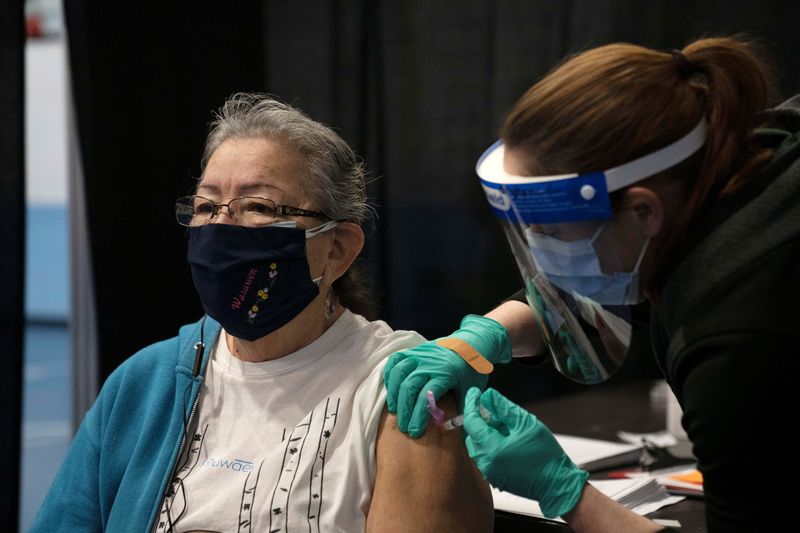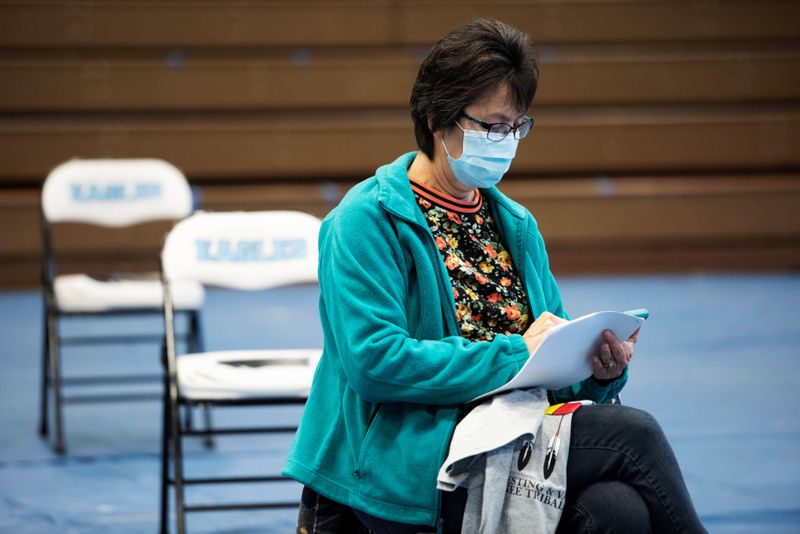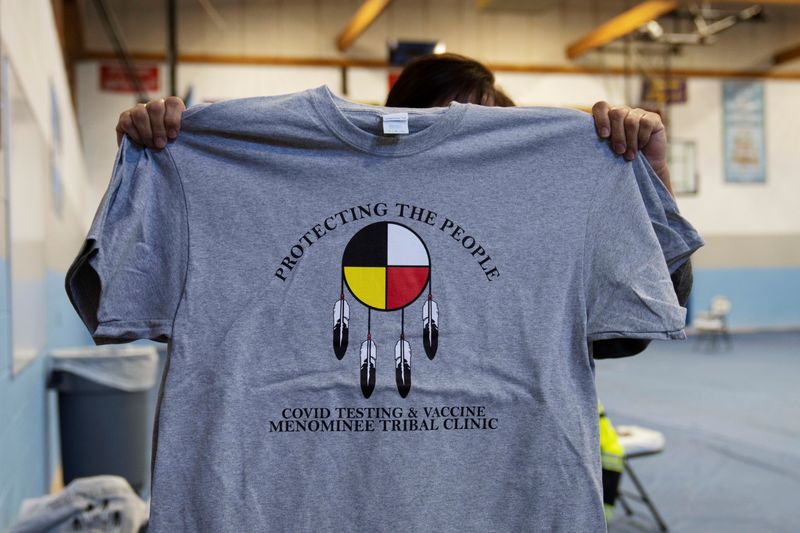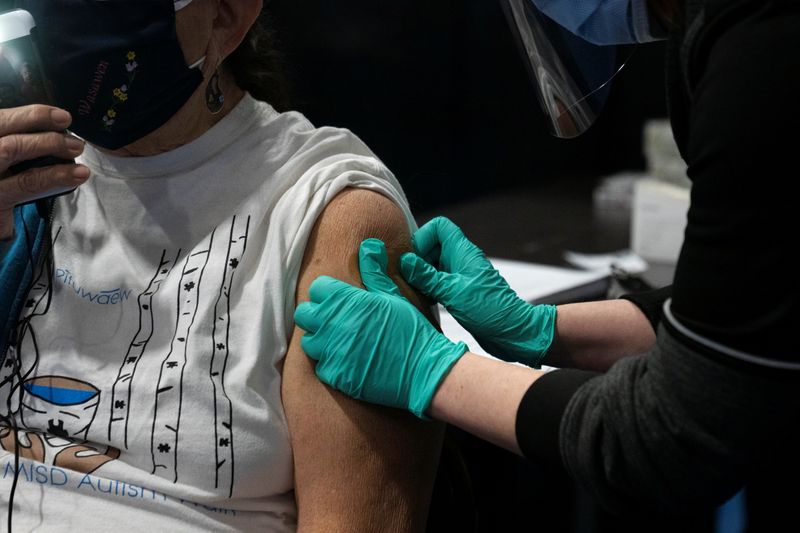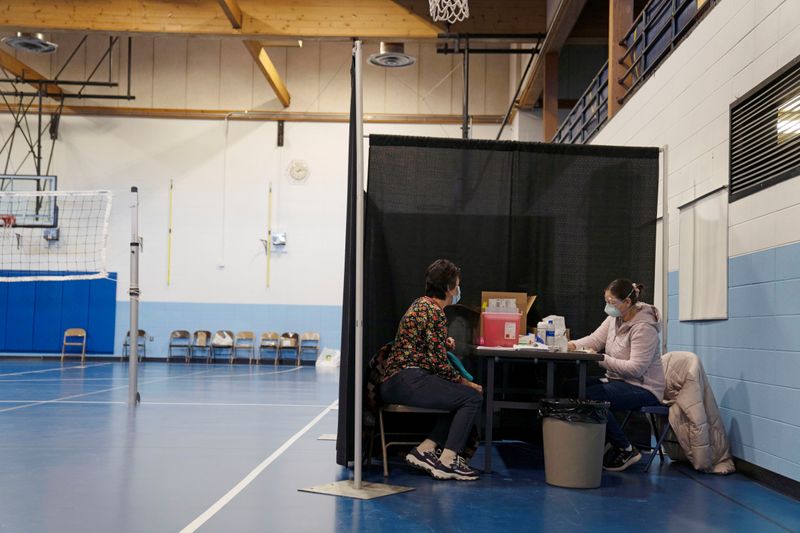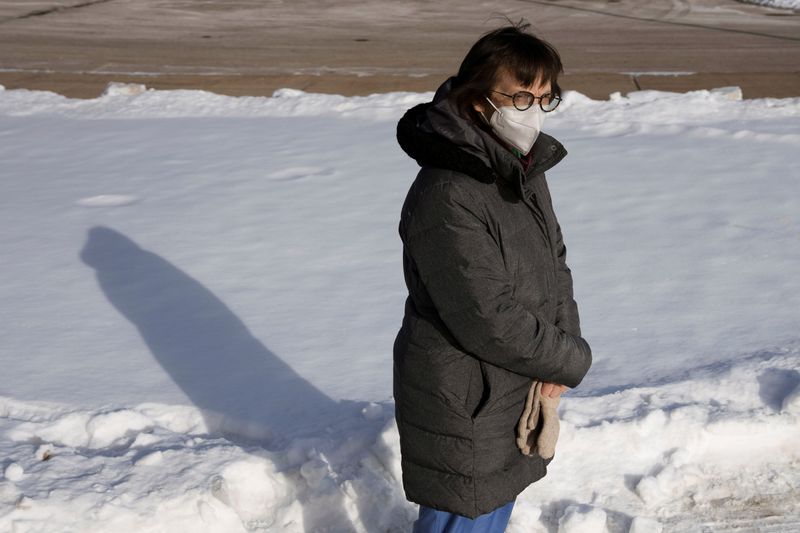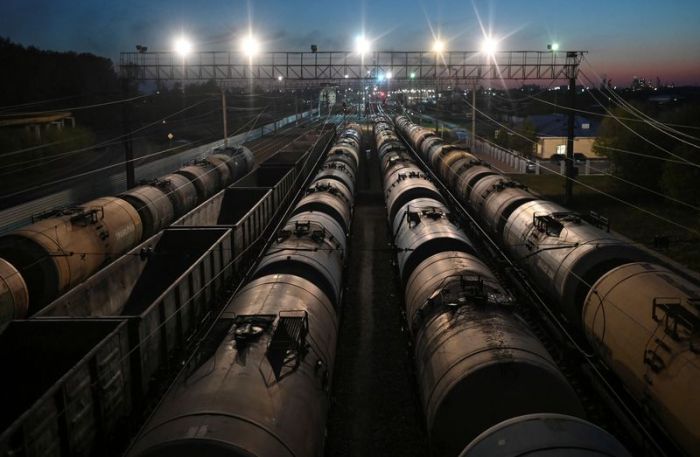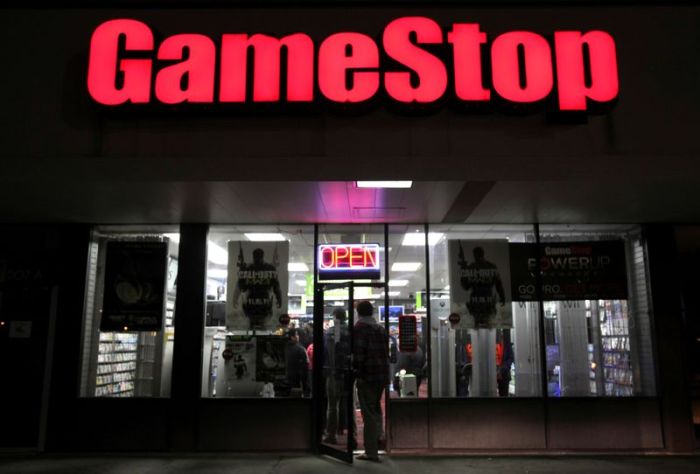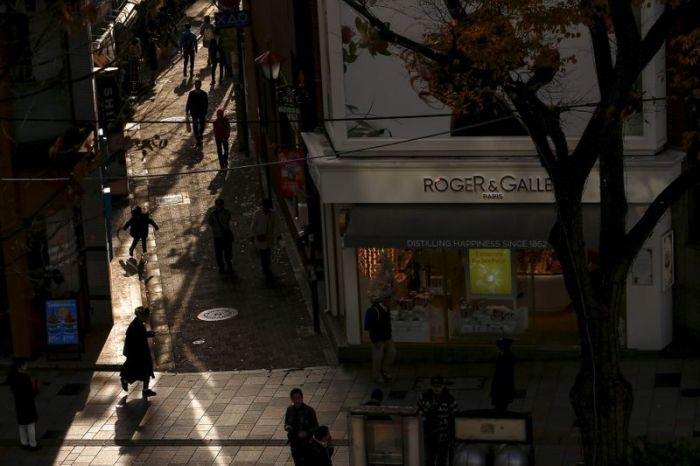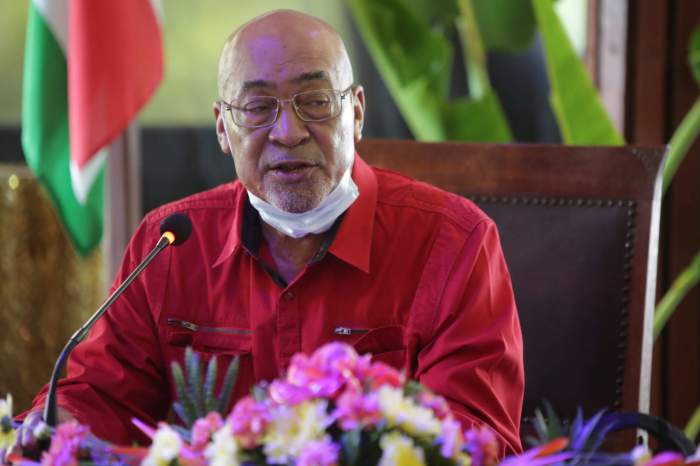(Reuters) – When Juan Carlos Guerra got the call on Jan. 12 that his county would receive 300 COVID-19 vaccine doses the following day, he went straight to work.
Guerra, the top elected official in rural Jim Hogg County, Texas, got together with local school superintendent Susana Garza, who was helping him lead vaccination planning. They called hundreds of vaccine-eligible residents to schedule appointments, in stark contrast to big cities, where locals report struggling through maddening online registration processes.
Guerra, who has spent his whole life in Jim Hogg, said he knew almost everyone he called, and they trusted him.
The next day, he and his staff staged a makeshift clinic at a local pavilion normally used for livestock shows – a plan they had hatched days earlier. Garza donated staff to help register patients, while a local home care company volunteered to screen everyone for fever.
With nurses from Texas’ state health department administering shots, the team exhausted their vaccine supply mere hours after it had arrived.
Many rural counties like Jim Hogg have excelled at getting injections into arms fast and efficiently, outpacing big cities despite disadvantages in healthcare infrastructure and finances, according to a Reuters review of vaccination data in several states through late January.
Data from Michigan, Wisconsin, Texas, North Carolina and Florida showed the highest per-capita vaccination rates often belonged to less populated counties.
Texas population graphic: https://graphics.reuters.com/HEALTH-CORONAVIRUS/VACCINES-RURAL/gjnvwrkdxpw/index.html
Texas per-capita vaccination graphic: https://graphics.reuters.com/HEALTH-CORONAVIRUS/VACCINES-RURAL/xegpbebxevq/index.html
Officials in rural communities said personal ties with constituents made it easier to overcome vaccine hesitancy and identify those eligible for early shots, according to interviews with 20 local and national officials, healthcare workers and vaccine recipients.
“We know each other here. We can pick up the phone and call one another,” said Casie Stoughton, public health director of Amarillo, Texas, which handles vaccinations for nearby rural counties.
States dominated by rural communities, such as Alaska, West Virginia and Minnesota, have vaccinated a higher share of their populations than more geographically mixed states, according to data from the U.S. Centers for Disease Control and Prevention.
Michigan population graphic: https://graphics.reuters.com/HEALTH-CORONAVIRUS/VACCINES-RURAL/nmopaobeepa/index.html
Michigan per-capita vaccination graphic: https://graphics.reuters.com/HEALTH-CORONAVIRUS/VACCINES-RURAL/xegpbebrevq/index.html
As the fledgling nationwide vaccination campaign gathers steam, rural county officials expressed concern they will get less from future vaccine allocations as urban areas clamor to catch up. But the early trend sheds light on an immunization program that is lagging behind initial targets.
With the Biden administration aiming to vaccinate every U.S. resident over age 16 by the end of summer, Reuters’ analysis suggests strong local communication and scrappy vaccination strategies will be crucial.
Officials in the most successful counties quickly set up makeshift vaccination sites with little bureaucratic red tape, and relied on personal appeals or word of mouth to fill appointments.
While those measures will be hard to duplicate in big cities, there are lessons to be learned as federal officials become more involved in the process.
COVID-19 has killed more than 427,000 people in the United States and threatens to overwhelm hospital systems nationwide, making a successful vaccination campaign crucial to getting the pandemic under control.
The lack of federal direction or funding to distribute vaccines under former U.S. President Donald Trump left states and counties to fend for themselves, resulting in a patchwork of strategies across the country.
President Joe Biden has vowed to accelerate distribution and give states up to three weeks notice of upcoming supply to address some of the current chaos, particularly in larger states.
Florida population graphic: https://graphics.reuters.com/HEALTH-CORONAVIRUS/VACCINES-RURAL/qmypmyqlzpr/index.html
Florida per-capita vaccination graphic: https://graphics.reuters.com/HEALTH-CORONAVIRUS/VACCINES-RURAL/ygdpzajowvw/index.html
In the meantime, rural health officials took matters into their own hands early on.
West Virginia – among the country’s poorest and most rural states with one of the oldest and sickest demographics – had vaccinated 9.2% of its population as of Jan. 26, more than any other mainland state.
The state recruited local pharmacies to vaccinate long-term care residents instead of opting into the federal government’s partnership with national pharmacy chains from CVS Health Corp and Walgreens Boots Alliance Inc.
“That’s allowed us to be a little bit more nimble,” said Krista Capehart, a director with the West Virginia Board of Pharmacy. The state began vaccinating long-term care patients Dec. 15, shortly after delivery and about two weeks before most states launched with CVS and Walgreens.
PITCHING IN
From the Texas deserts to the forests of Michigan’s Upper Peninsula and Florida’s coastline, rural health officials called on local hospitals, pharmacies, schools, police and firefighters to help set up vaccine clinics.
In Amarillo, for example, firefighters, parks officials and library workers pitched in, handing out water to those in the snaking vaccine line at the local civic center and monitoring patients post-vaccination.
Data from Michigan, Wisconsin, Florida, Texas and North Carolina – states chosen for their availability of county data and their rural/urban divides – showed they were typically leading urban counterparts in vaccination rates at the start of the rollout.
A Kaiser Family Foundation survey of 1,560 Americans in mid-January found that 54% of rural respondents said they had enough information on where to get vaccinated versus 38% among urban counterparts.
Wisconsin population graphic: https://graphics.reuters.com/HEALTH-CORONAVIRUS/VACCINES-RURAL/yzdvxgjmopx/index.html
Wisconsin per-capita vaccination graphic: https://graphics.reuters.com/HEALTH-CORONAVIRUS/VACCINES-RURAL/azgpolyonvd/index.html
In Menominee County, Wisconsin, Yvonne Tourtillott, a receptionist at the lone public health clinic, dropped everything to conduct phone blitzes when the county received vaccine doses in December and January, scheduling hundreds of appointments with the help of an Excel spreadsheet.
The effort paid off. The 4,500-resident county had vaccinated more than 400 people as of mid-January, giving it the third highest rate of Wisconsin’s 72 counties at the time.
Vaccination data is in constant flux, however, and some small counties that began at the top of their state’s rankings have sunk as states tweaked allocations to be equitable.
Brock Slabach, senior vice president at the National Rural Health Association, said rural health departments tended to be well connected, but added that access to vaccine supply was becoming a challenge.
‘NEWS TRAVELS FAST’
In Menominee County, which also serves as the Menominee Indian Reservation, devising a mass communication strategy is a big hurdle, said Dr. Amy Slagle, medical director of the county’s public health clinic. Officials fear phone blitzes will not be practical as more doses come in and many in the poor county lack reliable internet.
Many local officials also fear they could be effectively punished for their early efficiency, as state governments divert future doses to help other counties catch up.
A new batch of data released on Jan. 25 from Wisconsin showed Menominee’s per-capita vaccination rate had fallen from third to 29th in the state, with Slagle saying they had received just 10 doses in the prior week.
In Jim Hogg County, Guerra has urged the Texas Department of State Health Services (DSHS) to keep vaccines flowing to the deeply impoverished county, saying it “remains at a disadvantage” in healthcare access – a factor that can contribute to higher COVID-19 death rates.
Dr. Emilie Prot, the DSHS official in charge of the region, said vaccination rate is one of many factors determining allocation. “We want to make sure we’re equitable, and we can’t go back to the same places week to week.”
North Carolina population graphic: https://graphics.reuters.com/HEALTH-CORONAVIRUS/VACCINES-RURAL/jbyprnbyxpe/index.html
North Carolina per-capita vaccination graphic: https://graphics.reuters.com/HEALTH-CORONAVIRUS/VACCINES-RURAL/yxmvjyqmmpr/index.html
Some counties with strong vaccination efforts are getting more business than they bargained for.
Rural Davie County, which for many weeks led North Carolina in vaccination rate, has attracted vaccine-seekers from other parts of the state, said Wendy Horne, a spokeswoman for the local health department.
Davie residents Sue and Dave Sidden, a retired couple who recently received their second vaccine doses, attribute their county’s success to its tight-knit nature.
“There’s just no secret in a small community,” Sue said. “News travels fast here.”
(Reporting by Tina Bellon and Nick Brown in New York, and Lisa Baertlein in Los Angeles; Editing by Joe White and Bill Berkrot)

